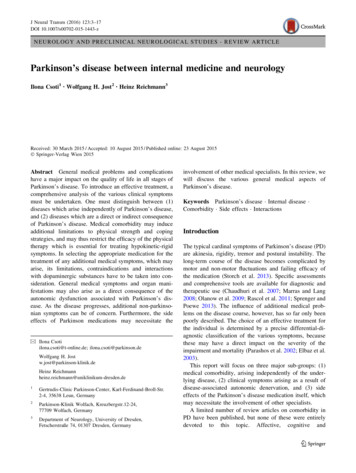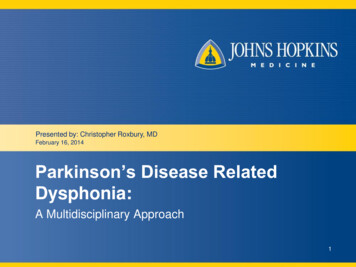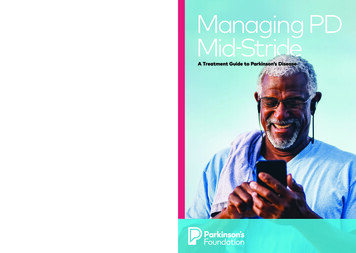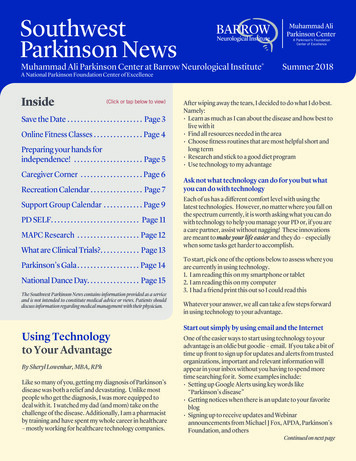
Transcription
J Neural Transm (2016) 123:3–17DOI 10.1007/s00702-015-1443-zNEUROLOGY AND PRECLINICAL NEUROLOGICAL STUDIES - REVIEW ARTICLEParkinson’s disease between internal medicine and neurologyIlona Csoti1 Wolfgang H. Jost2 Heinz Reichmann3Received: 30 March 2015 / Accepted: 10 August 2015 / Published online: 23 August 2015Ó Springer-Verlag Wien 2015Abstract General medical problems and complicationshave a major impact on the quality of life in all stages ofParkinson’s disease. To introduce an effective treatment, acomprehensive analysis of the various clinical symptomsmust be undertaken. One must distinguish between (1)diseases which arise independently of Parkinson’s disease,and (2) diseases which are a direct or indirect consequenceof Parkinson’s disease. Medical comorbidity may induceadditional limitations to physical strength and copingstrategies, and may thus restrict the efficacy of the physicaltherapy which is essential for treating hypokinetic-rigidsymptoms. In selecting the appropriate medication for thetreatment of any additional medical symptoms, which mayarise, its limitations, contraindications and interactionswith dopaminergic substances have to be taken into consideration. General medical symptoms and organ manifestations may also arise as a direct consequence of theautonomic dysfunction associated with Parkinson’s disease. As the disease progresses, additional non-parkinsonian symptoms can be of concern. Furthermore, the sideeffects of Parkinson medications may necessitate the& Ilona Csotiilona.csoti@t-online.de; ilona.csoti@parkinson.deWolfgang H. Jostw.jost@parkinson-klinik.deHeinz rtrudis-Clinic Parkinson-Center, Karl-Ferdinand-Broll-Str.2-4, 35638 Leun, Germany2Parkinson-Klinik Wolfach, Kreuzbergstr.12-24,77709 Wolfach, Germany3Department of Neurology, University of Dresden,Fetscherstraße 74, 01307 Dresden, Germanyinvolvement of other medical specialists. In this review, wewill discuss the various general medical aspects ofParkinson’s disease.Keywords Parkinson’s disease Internal disease Comorbidity Side effects InteractionsIntroductionThe typical cardinal symptoms of Parkinson’s disease (PD)are akinesia, rigidity, tremor and postural instability. Thelong-term course of the disease becomes complicated bymotor and non-motor fluctuations and failing efficacy ofthe medication (Storch et al. 2013). Specific assessmentsand comprehensive tools are available for diagnostic andtherapeutic use (Chaudhuri et al. 2007; Marras and Lang2008; Olanow et al. 2009; Rascol et al. 2011; Sprenger andPoewe 2013). The influence of additional medical problems on the disease course, however, has so far only beenpoorly described. The choice of an effective treatment forthe individual is determined by a precise differential-diagnostic classification of the various symptoms, becausethese may have a direct impact on the severity of theimpairment and mortality (Parashos et al. 2002; Elbaz et al.2003).This report will focus on three major sub-groups: (1)medical comorbidity, arising independently of the underlying disease, (2) clinical symptoms arising as a result ofdisease-associated autonomic denervation, and (3) sideeffects of the Parkinson’s disease medication itself, whichmay necessitate the involvement of other specialists.A limited number of review articles on comorbidity inPD have been published, but none of these were entirelydevoted to this topic. Affective, cognitive and123
4musculoskeletal comorbidities are statistically more likelyto internal diseases. Chronic medical diseases, such asarterial hypertension or diabetes mellitus, despite theirsometimes severe impact, have only a slight influence onoverall morbidity (Leibson et al. 2006; Guttman et al.2004; Gorell et al. 1994). This is surprising as many studieshave been published in which the relationship between PDand individual diseases has been examined; however, thesestudies did not consider the sometimes detrimental effectthe treatment of these additional symptoms can have on thefurther course of PD.The possible side effects associated with Parkinsonmedication are numerous, and are described in detail in thesummaries of product characteristics (SPC) issued bypharmaceutical companies for each product. Most of theseside effects, however, are infrequent and rarely lead todiscontinuation of the therapy. Cardiac valve pathology,subsequent to the use of ergoline dopamine agonists, is oneof the serious side effects associated with the use of PDmedication, and this led to very stringent limitations on thedrug approval in 2007 and to the withdrawal of pergolidefor human use in the USA (Zanettini et al. 2007). Realizingthat a particular non-PD symptom may possibly be relatedto a dopaminergic or anti-glutamatergic therapy is essentialfor determining the correct course of treatment. Our reportwill discuss the most important side effects which can leadto either a change of or the cessation of medication.The greatest cause of general medical problems in PD isPD itself, mostly due to the functional disturbances thatarise from the autonomic denervation which affects nearlyall the organs (Goetz et al. 1986; Senarda et al. 1997;Poewe 2008). For the present, the consequences of cardiacand gastrointestinal denervation in particular, and the reasons for involving specialists from other medical disciplines, will be addressed.The reciprocal influence of general medical and neurological complications in PD requires a close and continuous feedback between the neurologists and the othermedical specialists involved in the individual case. To date,there is a dearth of prospective studies on this topic.Some of the medical complications seen most frequentlyin everyday clinical settings will now be examined in thefollowing sections.General medical comorbidityPatients with PD exhibit a high rate of multi-morbidity. Invarious studies on comorbidity, up to 80 % of the patientshad five or more concomitant diseases (Gorell et al. 1994;Leibson et al. 2006). The significance of this lies not onlyin the higher degree of stress for the patient, but also in theconcomitant therapy of these medical diseases, as these can123I. Csoti et al.seriously influence the overall treatment success or the rateof mortality (Parashos et al. 2002; Elbaz et al. 2003; Doiet al. 2011). Viewing the results of these studies, it isapparent that, for at least the first years of PD, typicalmedical diseases (such as diabetes mellitus) do not occurmore frequently among PD patients when compared tocontrol groups (Leibson et al. 2006). An increase in agecorrelated comorbidity cannot be found until after10–15 years with PD and is clearly related to complications and sequelae of PD (Leibson et al. 2006). Most frequent among these comorbidities are diseases of the jointsand fractures (Leibson et al. 2006; Melton et al. 2006;Natalwala et al. 2009; Jones et al. 2012). In contrast, otherintercurrent diseases such as pneumonia or cardiovasculardisease are the principle cause of death in all mortalitystudies (Gorell et al. 1994; Ben-Shlomo and Marmot 1995;Pinter et al. 2014).Diabetes mellitusAlthough the data from several cohort studies revealed ahigh level of comorbidity between PD and diabetes mellitus, these results have not been consistent (Cereda et al.2011). A number of retrospective case studies have showna tendency for the co-occurrence of diabetes and PD, whilstother studies failed to corroborate this finding (Gorell et al.1994; Leibson et al. 2006; Hu et al. 2007; Becker et al.2008; Jones et al. 2012). Other clinical studies reported anincreased risk of over 40 % for patients with diabetes todevelop PD (Miyake et al. 2010; Xu et al. 2011; Sun et al.2012). In one population-correlated cohort study with anobservation period of 12 years, there was a 2.2-foldincreased risk for contracting PD, and this risk was in factraised by a further 57 % if the diabetics had been treatedwith sulfonylurea (Wahlqvist et al. 2012).The development of diabetes by PD patients is correlated with increased cognitive deficits, gait disturbance andpostural instability (Bohnen et al. 2014; Kotagal et al.2013). Recent genetic research has found an associationbetween both PD and diabetes mellitus and the SOD2*Valpolymorphism (Santiago et al. 2014).The oral antidiabetic, metformin, has proven to beeffective in the therapy of diabetes mellitus, and now,because of its neuroprotective and pro-dopaminergicqualities, is attracting attention in animal models of PD andin the treatment of PD patients. (Wang et al. 2012; Pottsand Lim 2012; Adeyemi et al. 2013; Patil et al. 2014;Wahlqvist et al. 2012). The potential deficiency in vitaminB12 which is linked to metformin use has been associatedwith the occurrence of polyneuropathy (Bell 2010). Aspolyneuropathy is a frequent neurological complication ofdiabetes mellitus, and as vitamin B12 deficiency has alsobeen described in PD, screening for vitamin B12 deficiency
Parkinson’s disease between internal medicine and neurology5is recommended for patients with diabetes and PD(Kästenbauer et al. 2004; Madenci et al. 2012; Ceravoloet al. 2013). If diabetic nephropathy occurs as a result ofdiabetes mellitus, dose adjustment has to be consideredwhen amantadine, budipine and pramipexole are beingprescribed (see http://www.dosing.de) (Horadam et al.1981; Hong et al. 2008).Previous studies have also suggested an associationbetween PD and obesity as comorbidity. In a cross-sectional study in the PD group 19.2 % were obese (MoralesBriceño et al. 2012). In a Mexican general population, theprevalence for overweight was 20.3 % (OR 1.45,p \ 0.0001, CI 95 % 1.65–2.12), compared to generalpopulation (Llorens-Arenas et al. 2015).DyslipidemiaArterial hypertensionThe data on hypercholesterolemia and PD are inconsistent(Hu et al. 2008; Miyake et al. 2010). One recent metaanalysis failed to find an increased association betweenelevated serum cholesterol and PD (Gudala et al. 2013).HMG-CoA reductase inhibitors (statins) may arguablyhave an anti-inflammatory, immune-modulating and neuroprotective effect (Gao et al. 2012; Undela et al. 2013). Ina meta-analysis, a relative reduction in risk of 29 % wasfound for PD, but only for the group of patients under theage of 60 (Gao et al. 2012). Nonetheless, the risk for cardiovascular complications is increased for patients with PDand hypercholesterolemia (Firoz et al. 2015).Huang et al. prospectively examined plasma lipids andstatin use in relation to PD in the Atherosclerosis Risk inCommunities (ARIC) Study. Statin use and plasma lipidswere assessed at baseline and at three triennial visitsthereafter until 1998. Statin use may be associated with ahigher PD risk, whereas higher total cholesterol may beassociated with lower risk. These data are inconsistent withthe hypothesis that statins are protective against PD (Huanget al. 2015).The role of arterial hypertension as a risk factor for thedevelopment of PD has been examined in a number ofcase–control and retrospective studies, showing that therisk for developing PD was rather lower for hypertensivepatients than for those with normotension (Miyake et al.2010; Qiu et al. 2011; Mazza et al. 2013). Cardiac denervation in PD complicates the therapy for arterialhypertension through some special features of bloodpressure in PD patients. Reducing blood pressure withmedication in a supine patient increases the risk of asymptomatic OH. To avoid this, prescribing short-actingantihypertensives can be recommended for the timebetween meals, for the later afternoon or in the evening(Mazza et al. 2013). Some of the antihypertensives (suchas calcium antagonists and ACE inhibitors) are attributedwith a neuroprotective effect towards the development ofPD (Rodnitzky 1999; Ritz et al. 2010; Mazza et al. 2013;Sato et al. 2014), something which, however, could not beconfirmed in individual studies or in a Cochrane analysisin 2011 (Simon et al. 2010; Rees et al. 2011a; Marraset al. 2012). The calcium antagonist isradipine is anexception (Simuni et al. 2010; Ilijic et al. 2011; Kanget al. 2012; Simuni et al. 2013). A Phase II study iscurrently being conducted by the Parkinson Study Groupinto the drug safety and compatibility of isradipine in themodification of PD in early stages of the disease (Simuniet al. 2010). A retrospective case analysis of 341 PDpatients has found interesting results, showing that comedication with beta blockers was associated with aweaker risk of developing PD (42.4 versus 65.6 % without beta blockers in the concomitant medication) (Paganoet al. 2014).In selecting the appropriate antihypertensives, activesubstances which, based on their pharmacological properties, can cause drug-induced parkinsonism, should beavoided. Studies on this relationship have been done foralpha-methyldopa (Strang 1966; Vaidya et al. 1970;Rosenblum and Montgomery 1980), reserpine (Birkmayerand Hornykiewicz 1964; Lorenc-Koci et al. 1995), calciumchannel blockers (flunarizine, cinnarizine, amlodipine)(Montastruc et al. 1994; Sempere et al.1995; Teive 2002),diltiazem (Dick and Barold 1989; Graham and StewartWynne 1994; Remblier et al. 2001), verapamil (MalaterreObesityThe relationship between obesity and PD is discussed verycontroversially. Dopamine is involved in the regulation offood intake. Obese persons have decreased dopamine D2receptor availability in the striatum (Chen et al. 2004).Based on this scientific knowledge, the relationshipbetween obesity and the risk of Parkinson’s disease wasseveral scientifically investigated. Chen et al. studied theassociation between obesity and the risk of PD in two largecohorts of US man and women from the ‘‘Health Professionals Follow-up Study’’ and the ‘‘Nurses’ Health Study’’.The results do not support a role of overall obesity in PDpathogenesis, however, central obesity may be associatedwith higher PD risk among never smokers (Chen et al.2004). Also in the Harvard Alumni Health Study, the bodymass index (BMI) was unrelated to Parkinson’s disease risk(Logroscino et al. 2007). Hu et al. found in a Finnish cohortthat the risk of PD was twice as high in men with BMI over30 and there was a 70 % higher risk among women (Huet al. 2006).123
6et al. 1992; Padrell et al. 1995), captopril (Sandyk 1985)and moxonidine (Webster and Koch 1996).Obstructive sleep apnea syndrome (OSAS)Patients with PD can develop obstructive sleep apneasyndrome (OSAS). OSAS causes daytime sleepiness,nocturnal high blood pressure, and glucose intolerance.There is no conclusive evidence to support the associationbetween PD and the prevalence of OSA. A meta-analysisevaluates five eligible studies including 322 cases and 6361controls. The results suggest that there is a significantnegative association between PD and the prevalence ofOSA. Patients with PD generally have a reduced prevalence of OSA (Zeng et al. 2013). In cases of PD withmoderate or severe OSAS, the use of continuous positiveairway pressure (CPAP) is established in treatment. Thepatients responded to therapy and regained more daytimeactivity. Therefore, sleep diagnostic evaluation is recommended to rule out sleep apnea as a cause for hypersomnolence (Steffen et al. 2008).CardiomyopathyComorbidity between cardiomyopathy and PD is significantly raised compared to controls and reaches 19.4 %(Zesiewicz et al. 2004). One possible cause of this—thebasic deficit of sympathetic innervation in PD—is stillunder discussion (Satoh et al. 1999). The postsynapticnoradrenaline uptake in sympathetic nerve endings of theheart, as measured with MIBG-SPECT (123-I-MetaIodobenzylguanidine), serves as a marker for this disorderof innervation (Satoh et al. 1999). Studies using nuclearimaging, however, failed to confirm an associationbetween orthostatic dysregulation (the clinical correlate ofan autonomous functional disorder) and the cardiovascular disorder, so that it is now being postulated that theirdevelopment is fully independent of one another (Haenschet al. 2009; Leite et al. 2014). Studies undertaken in ananimal model found only a weak effect of cardiomyopathy on the progression of PD (Xu et al. 2014). Similarly,no significant negative effect of Levodopa therapy oncardiac disease could be documented (Jenkins et al.1972).When diuretics are called for to treat cardiac insufficiency, a combination of amantadine and dyazide (hydrochlorothiazide, triamterene) should be avoided. Dyazidereduces the clearance of amantadine, and thus toxic plasmalevels are possible (Wilson and Rajput 1983). Single casereports have described akinesia, tremor, drug-inducedparkinsonism and severe gait ataxia arising from the use ofthe anti-arrhythmic amiodarone (Lombard et al. 1986;Werner and Olanow 1989; Dotti and Federico 1995;123I. Csoti et al.Malaterre et al. 1997; Krauser et al. 2005; Ishida et al.2010). The causative factor was attributed to amiodaroneinduced dysfunction of the basal ganglia (Werner andOlanow 1989). A postmortem case report described thetoxic accumulation of amiodarone in the basal ganglia(Ishida et al. 2010). The cumulative incidence of a possiblyneurotoxic effect of amiodarone (tremor, gait ataxia,peripheral neuropathy, cognitive deficits) was found to be2.8 % in a retrospective case analysis (Orr and Ahlskog2009).Gastritis and gastroesophageal refluxThe prevalence of gastroesophageal reflux disease (GERD)is high in PD, and reaches 65 % in patients 4 years afterdiagnosis (Makaroff et al. 2011; Maeda et al. 2013).Therapy is conducted with proton pump inhibitors (PPI).Single case studies have documented a dose-dependentincrease in the incidence of vitamin B12 deficiency, fractures and infections with clostridia in at-risk patients,although it must be admitted that randomized controlledstudies are as yet lacking (Hirschowitz et al. 2008; Rozgony et al. 2010; Heidelbaugh 2013). Usage of PPI in strictdosage is recommended and should be adhered to thesepatients with GERD (Abraham 2012; Leibson et al. 2006;Madenci et al. 2012).Helicobacter pylori infectionThe prevalence of helicobacter pylori (HP) infection in PDpatients is high and ranges from 37 to 59 % in differentpublications (Rees et al. 2011b). In several case–controlstudies, a negative influence has been reported for HPinfection of the stomach lining on the absorption of levodopa and subsequent motor behavior in patients with PD(Tan et al. 2014b). According to some authors (Pierantozziet al. 2006; Lee et al. 2008), eradication improves the effectof the levodopa and leads to a reduction in the rate offluctuations. A review article from the Cochrane Collaboration, however, found but few indications for animprovement in motor behavior, so that screening of PDpatients for HP cannot be recommended at present (Reeset al. 2011b). As a result of untreated and chronic gastritisdue to HP infection, an iron deficiency anemia can occurwhich disappears spontaneously after successful eradication. One study involving 22 patients, however, found nodifference between eradication with and without iron substitution (DuBois and Kearney 2005). If iron substitution isconsidered necessary in Parkinson’s patients, an interval ofat least 2 h should be observed between the use of the ironpreparation and levodopa/DDCI or a COMT inhibitor, asotherwise chelation can occur (Orama et al. 1997; Kaakkola 2000).
Parkinson’s disease between internal medicine and neurologySmall intestinal bacterial overgrowth syndrome(SIBO)Several studies have reported finding an increase in theprevalence of small intestinal bacterial overgrowth syndrome (SIBO) in PD (Gasbarrini et al. 2007; Gabrielli et al.2011). A possible association of SIBO presenting withgastrointestinal symptoms and a worsening of motorbehavior is being considered at present (Gasbarrini et al.2007; Fasano et al. 2013; Tan et al. 2014a). In a studyinvolving 33 patients and 30 controls, 54.5 % of PDpatients and only 20 % of controls (p 0.01) had SIBO.The affected PD patients had longer off-phases and morefrequent delayed-on and no-on episodes (Fasano et al.2013). Gastrointestinal hypomotility in PD with delayedperistalsis and a disorder in the functioning of the Valvaileocaecalis are under consideration as the possible causalfactor (Gabrielli et al. 2011). Under standard studyrequirements, melevodopa (levodopa methyl ester) provedto be more effective than levodopa in patients with PD andSIBO due to changes in the pharmacological dynamics(Fasano et al. 2014).Leaky gut syndrome (LGS)Recent studies suggest that leaky gut syndrome, in association with an abnormally heightened intestinal permeability (gut leakiness) for enterobacteria and exogenictoxins from the intestinal lumen, is more frequent in PD. Inview of the studies by Braak et al. (2003), the relationshipbetween the subsequent changes in the intestine and thepathophysiology of PD has attracted substantially moreattention (Forsyth et al. 2011; Scheperjans et al. 2014).LGS is presently being investigated extensively innumerous study projects [Increased Gut Permeability toLipopolysaccharides (LPS) in Parkinson’s Disease,NCT01155492, Quantitative Analysis of Gut-derivedNeuropeptides in Cerebrospinal Fluid (CSF) of PatientsWith Parkinson’s Disease and Healthy Controls,NCT01792193, etc.].Clinical disorders arising as side effectsof Parkinson’s disease medicationFibrosis and fibrotic cardiac valve damageAs early as the early 1990s, individual case reportsdescribed fibrotic changes in various organs such as pleural, pericardial and retroperitoneal fibroses in patientsreceiving the ergoline dopamine agonists bromocriptine,pergolide and cabergoline (Jiménez-Jiménez et al. 1995;Lund et al. 1999; Shaunak et al. 1999; Mondal and Suri72000; Bilici et al. 2004; Apostolakis et al. 2009; Elenkovaet al. 2012). In addition, since 2007, numerous observational studies have shown a relationship between theergoline dopamine agonists pergolide and cabergoline andthe occurrence of fibrotic cardiac valve damage (Antoniniand Poewe 2007; Zanettini et al. 2007; Schade et al. 2007;Steiger et al. 2009). Pathophysiologically, it has beenproposed that activation of the 5-hydroxytryptamine 2Breceptors (5HT2B) located on the cardiac valves stimulatesthe growth of fibroblasts in the endocardium (Setola et al.2003; Horowski et al. 2004). This hypothesis was confirmed in a large cohort study involving 11,417 participants. An increased incidence of fibrosis (dose dependent,over 3 mg/day) was found with pergolide (sevenfoldincrease) and cabergoline (fivefold increase), and bothsubstances had a strong 5-HT2B affinity. No associationcould be found for ropinirole, pramipexole or rotigotine(Andersohn and Garbe 2009). According to a publicationof the FDA, pergolide was then withdrawn from the marketby the manufacturers (FDA 2007) while drug approval forpergolide and cabergoline was maintained in Europe andJapan but subject to the following restrictions: both dopamine agonists are considered as drugs of second choice andthe maximum daily dose for both preparations is set at3 mg. If therapy should call for one of these medications,close monitoring of echocardiographical and medicalparameters is mandatory. A prior fibrotic condition orcardiac valve stenosis is a contraindication (EMA 2008).Cardiac insufficiencyIn 2012, the FDA announced for the first time that therewas a possible association between pramipexole and therisk of cardiac insufficiency. Such indications had arisen inan evaluation of the side effects documented in thepramipexole approval studies from 2010 (FDA 2012). Anepidemiological study performed by the manufacturerrevealed an increased risk of cardiac insufficiency forpramipexole (RR 1.86) and for cabergoline (RR 2.07)(Renoux et al. 2012). In a second large cohort study, utilizing the results obtained from the United KingdomGeneral Practice Research Database (GPDR), the use ofpramipexole was associated with a greater risk for cardiacinsufficiency (odds ratio 1.61). This increase in risk wasespecially apparent in the first 3 months of treatment and inpatients aged 80 years or over (Mokhles et al. 2012). Ameta-analysis in 2014 confirmed this increased risk forpramipexole and cabergoline (Perez-Lloret et al. 2014). Todate, there have been no therapy limitations or healthwarnings for pramipexole due to insufficient data. Use ofcabergoline has been severely limited at any rate, becauseof the risk of developing fibrosis. Further studies werecalled for by the FDA.123
8Single case studies have reported the occurrence ofcardiac insufficiency under amantadine (Vale and Maclean1977; Parkers et al. 1977).Peripheral edemasThe occurrence of peripheral edemas, most notably in theankles and the lower legs, has been associated with dopamine agonists and amantadine, with the frequency rangingbetween 5 and 40 %. In a retrospective analysis from theCALM-PD Study, risk factors for the occurrence ofperipheral edemas under pramipexole were found forfemale gender and cardiac comorbidity (Biglan et al.2007). A single case of massive lymph edema associatedwith pramipexole treatment, which resolved followingcessation of the drug, has been reported (Zavala et al.2012). In one long-term study on ropinirole extendedrelease, 38.6 % of the patients developed peripheral edemas (Hauser et al. 2011). A lower degree of risk was foundin studies on rotigotin (7 %) and piribedil (5 %) (Giladiet al. 2013; Castro-Caldas et al. 2006). Edemas underamantadine were associated with peripheral vasoconstriction (Pearce et al. 1974).In individual cases, amantadine has been associated withthe following diseases: Livedo reticularis, SIADH (syndrome of inappropriate antidiuretic hormone secretion),hyponatremia and cornea edemas (Pearce et al. 1974;Blanchard 1990; Fraunfelder and Meyer 1990; Lammersand Roos 1993; Gibbs et al. 2005; Alonso Navarro et al.2009; Trenkwalder et al. 2007; Kim et al. 2013).Arrhythmia due to long QT syndromeSome Parkinson’s medications may induce prolongation ofthe QT interval and as a result increase the risk ofarrhythmia of the Torsades de Pointes (TdP) type. For thisreason, very close supervision is called for when administering budipine (Scholz et al. 2003). When two drugswith a potential for QT prolongation are administered incombination, the risk is increased by 70 % and for this veryreason is contraindicated (Heist and Ruskin 2005). Evenamantadine can lead to a QT prolongation (Manini et al.2007). Drugs with this risk for QT prolongation whenfrequently administered in Parkinson’s patients alsoinclude apomorphine, domperidone, citalopram and escitalopram. For a review of other drugs, see ists.htm.I. Csoti et al.patients are taken off the drug. Case reports have describedthe occurrence of colitis under entacapone and StalevoÒ(levodopa/carbidopa/entacapone) (Maroy 2008; Lim et al.2008). Pathological liver test results are a contraindicationfor COMT inhibitor therapy.COMT inhibitors harbor the potential for liver toxicity,and in the case of tolcapone but not of entacapone, thisconstitutes a safety risk (Haasio et al. 2002). Following themarket authorization for tolcapone in 1997, three patientsdied from acute liver failure, which led to the withdrawalof the drug from the European market. However, furthersafety evaluations led to its re-approval in 2004 (Borges2003; Brooks 2004). Tolcapone is now considered as aCOMT inhibitor of second choice in treating advancedParkinson’s disease when fluctuations are present, butnonetheless regular liver enzyme monitoring is mandated.In rare cases even the dopa decarboxylase inhibitorbenserazide (contained in levodopa/benserazide formulations) can cause diarrhea (Csoti and Fornadi 2011).Changing to levodopa/carbidopa is in most cases beneficial. The risk of diarrhea is especially apparent with singledoses of benserazide of over 25 mg (as in MadoparÒ250 mg). Because tolcapone, due to drug interactions, canin turn raise the benserazide levels, a combination of200/50 mg levodopa/benserazide formulations with tolcapone should be avoided (summary of product characteristics for Tasmar 100 mg 2013).Pathological glucose tolerance and insulin resistanceunder L-DopaDopamine influences insulin secretion. There are descriptions in the literature of a tonic inhibition of glucose-controlled insulin secretion from the b-cells of the pancreas(Ustione et al. 2013). Sirtori et al. (1972) investigated themetabolic effect of Levodopa in 24 patients and foundpathological glucose tolerance after a treatment time of1 year and an increase in serum cholesterol of approximately 10 %. Insulin resistance has also been described asbeing significantly higher among Parkinson’s patients withdementia (Bosco et al. 2012).Symptoms of autonomic dysfunctionCardiovascular autonomic disordersSyncopes in orthostatic hypotensionDiarrheaDiarrhea is a frequent or very frequent non-dopaminergicside effect when patients are treated with COMT inhibitors(Parashos et al. 2004; Kaakkola 2010), persisting even after123The most common autonomic disorder within the cardiovascular system in PD is orthostatic hypotension (OH),which in the literature is reported to affect 30–60 % ofpatients (Bellon et al. 1996; Senarda et al. 1997). The
Parkinson’s disease between internal medicine and neurologyassumption that this disorder does not appear until theadvanced stages of PD has been disproven in more recentstudies (Jost and Augustis 2015). These patients typicallyhave a sudden drop in blood pressure below the criticallimit for cerebral autoregulation after a change of position,postprandially or in the recovery phase after physical strain(Jost 1995; Loew et al. 1995; Mehagnoul-Schipper et al.2001; Ejaz et al. 2006; Ziemssen et al. 2006). Assumedcausal factors include: (1) cardiac noradrenergic denervation as demonstrated in MIBG-SPECT (meta-iodobenzylguanidine), (2) extra-cardiac noradrenergic dysfunctionand (3) a disturbance of the cardiovagal and symp
2004). Also in the Harvard Alumni Health Study, the body mass index (BMI) was unrelated to Parkinson's disease risk (Logroscino et al. 2007). Hu et al. found in a Finnish cohort that the risk of PD was twice as high in men with BMI over 30 and there was a 70 % higher risk among women (Hu et al. 2006). Previous studies have also suggested an .










